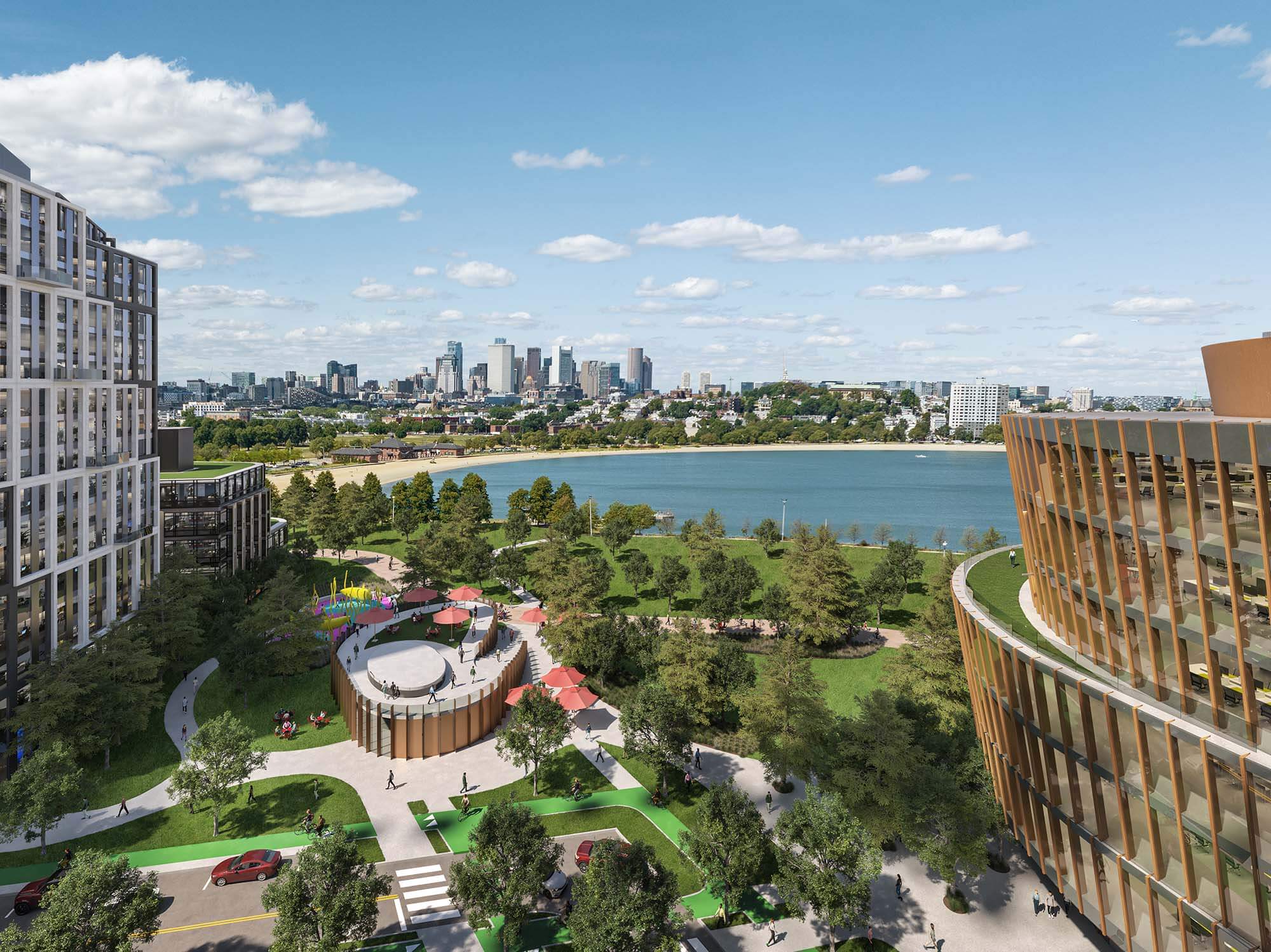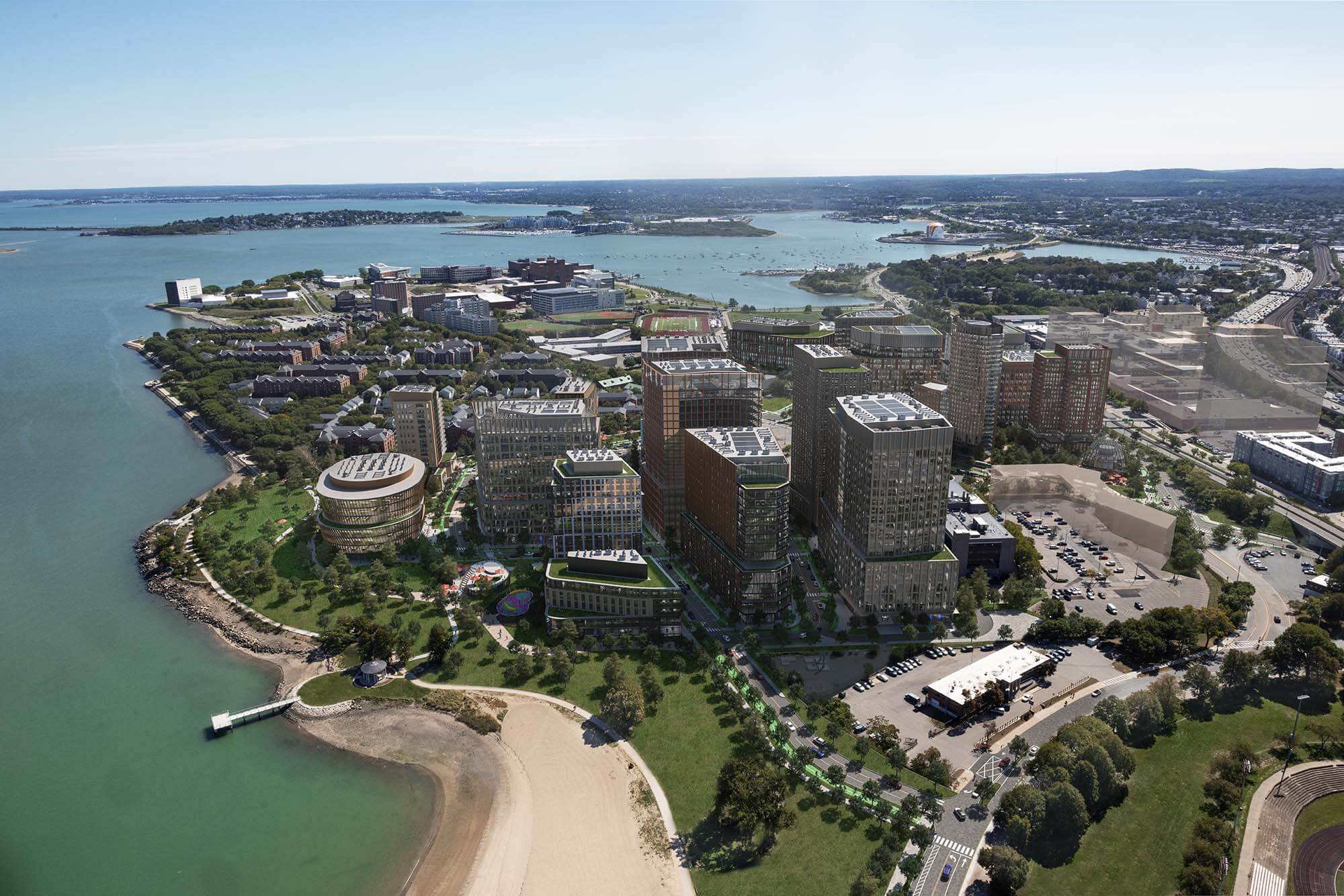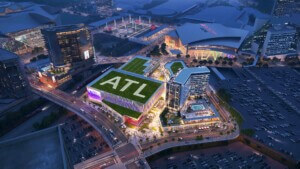Dorchester is the largest, most socio-economically diverse neighborhood in Boston. And after years of fast growth mostly contained to the Seaport District and South Boston, it’s also home to the city’s next megaproject: Dorchester Bay City, a $5 billion, 21-building, 5.9-million-square-foot complex on the Boston waterfront that will accommodate an abundance of retail and restaurant space; 1,957 residential units, 20 percent of which will be income-restricted; and 15.4 acres of open space.
In the “city on a hill” of 650,000 people, adding nearly 2,000 new rentals to the market is a big deal. The masterplan by DREAM Collaborative, along with Stantec, and Accordia Partners, was approved by the city’s architectural review board this July after over “600 community meetings” with neighborhood associations, according to Jenn Cartee from Dorchester Growing Together, a housing advocacy group. “Given the incredible regional shortage of housing, caused by exclusionary zoning artificially limiting what has been able to be built here for decades, Dorchester Bay City’s approval to create 1,957 new homes, 20 percent income-restricted, on Columbia Point right next to the T is wonderful news,” Cartee told AN. “The developers are also contributing $10 million to the Massachusetts Affordable Housing Alliance’s first generation home buyer program, which does great work statewide helping people build long term equity.”
Elected officials including Congressman Stephen Lynch, who represents the area, also welcome the current plan, along with the Black Economic Council of Massachusetts. “When fully built, Dorchester Bay City will be one of the largest minority-led developments in the country,” Lynch told local reporters this July.

Dorchester Bay City’s recent approval comes amid a devastating housing crisis. In 2020, a study by The National Community Reinvestment Commission ranked Boston the third “most intensely gentrified” city in the U.S. after San Francisco and Denver. As of 2023, Greater Boston’s vacancy rate is 0.49 percent, what The Boston Globe called a “record low” in the city’s history. In a “healthy” market, Boston’s vacancy rate should be closer to 6 percent, according to Demetrios Salpoglou, CEO of BostonPads. “Apartments on Zillow go off the market in hours,” Katie Ladd, 30, a Harvard graduate student told AN.
The 20-acre parcel where Dorchester Bay City is set for construction is a short walk from I.M. Pei’s iconic John F. Kennedy Presidential Library, completed in 1974. It also abuts a mixed-income community called Harbor Point, formerly known as Columbia Point, a 50-acre public housing project completed in 1953—the largest in Boston’s history, and one of its first integrated public housing estates.
Columbia Point was built a year before Minoru Yamasaki’s infamous Pruitt-Igoe in St. Louis, an architecturally similar project with comparable social ambitions: to provide federally-funded mass housing for everyone to live affordably in comfortable, spacious dwellings. Before shovels broke ground, like Pruitt-Igoe, Columbia Point was planned as an integrated, working class community with 1,504 publicly-owned residential units spread across 27 brick towers. It had its own subway stop, school, church, playing fields, and community health center. Tenants in landlord-owned slums from throughout Boston lined up in droves for rental applications to live in the Ville Radieuse–inspired neighborhood, and in just a few years, thousands of people were lifted from derelict poverty conditions when it was finished.
Overall, Columbia Point’s demographics largely matched the city it was built in: 90 percent of renters were white and the remaining were predominantly Black. For a decade, sociologists who tracked Columbia Point’s development noted that it was a model community where diverse Boston residents lived amicably despite the city’s long bouts of racial strife, according to Michael Feldberg who documented the peninsula’s history.
Regardless of Columbia Point’s early success, it didn’t last, and the utopian optimism driving projects like Pruitt-Igoe from the 1950s began to simmer as the federal government divested from public housing. Later in 1963, leading up to the city’s busing crisis, the Boston Housing Authority (BHA) segregated the complex when it relocated white residents to nearby, publicly-owned buildings in South Boston; at the same time moving Black renters from BHA properties around the city to Columbia Point, creating an isolated, racialized enclave. By the 1980s, after decades of disinvestment and neglect, only a few hundred predominantly Black families remained in what was once a vibrant, mixed, almost utopian neighborhood.
Like Pruitt-Igoe, Columbia Point was demolished in 1986 and replaced with New Urbanism–inspired, mid-rise residential buildings by Boston-based Goody Clancy. That same year, Columbia Point was subsequently renamed “Harbor Point” for a makeover by Joe Corcoran, a local developer who flipped the property into predominantly market rate housing. In turn, two-thirds of the new units at Harbor Point were market rate while the remaining third were public, a dramatic decrease compared to Columbia Point, matched with a “24 hour security force to restore law and order.” The redevelopment was hailed as the “first mixed income development” in the U.S. and a model for fixing “failed public housing.” Witold Rybczynski in ARCHITECT called Harbor Point “visionary” while deriding its predecessor Columbia Point as a “no-man’s land of crack houses, street crime, and lawlessness.”
Today, the UMass Boston Coalition Against Gentrification, a group of students and faculty who are critical of Dorchester Bay City, have called attention to the fact that the new development fails to make pedestrian connections between it and Harbor Point, exacerbating its exclusivity. In 2019, the group published a list of ten actionable items it says would make for a more equitable development.

The site is currently owned by the University of Massachusetts who leased it to Accordia Partners for $235 million in 2019. The lot itself however has been a hot potato for city officials and developers for decades. Since the 1970s, it’s been home to the Bayside Expo Center, a bank, and the Boston Teachers Union, amounting to a few glum buildings within a sea of empty parking lots. The massive plot was slated to become Boston’s Olympic Village when Mayor Menino nearly brought the 2024 Olympic Games to the city. Later, the Walsh administration wanted to build a new stadium there for the New England Revolution, the region’s professional soccer team, until that deal floundered. Nothing seemed to stick until 2019 when UMass Boston former interim chancellor Katherine Newman struck an agreement with Accordia to repurpose the site for housing and commercial uses.
Following this July’s approval, construction is set to begin in the next few years. Today, however, advocacy groups like Dorchester Not for Sale are concerned that injecting thousands of new, high-income earners will threaten Dorchester’s affordability; a blue-collar neighborhood that’s been a gateway for immigrants since the 1800s. Many worry that Dorchester Bay City is destined to become a carbon copy of the Seaport District, a nearly complete $22 billion megaproject on the Boston waterfront that, before shovels broke ground two decades ago, activists hoped would be packed with truly affordable homes and public greenspace. Thanks to a series of zoning variances and murky real estate deals, this isn’t what happened. At the Seaport, the city has a heterogenous enclave of tech workers, luxury buildings by a few starchitects, and boutique brands where the median home price is $2.15 million and its median household income is $153,545.
Then there are concerns about Boston’s transit system being able to support Dorchester Bay City, and the massive influx of population it will add to the already declining network. Locals refer to the nearby Kosciuszko Circle as “the rotary from hell” due to the dozens of near catastrophic accidents that take place there daily. Moreover, the Massachusetts Bay Transportation Authority (MBTA) has been in a fiscal crisis for years, and struggles to pay for vital service upgrades. In 2019, a subway car at the station that will anchor Dorchester Bay City, JFK/UMass, derailed when passengers were aboard. No one was badly hurt, but the situation revealed the dire straits Boston public transit finds itself in.
To assuage these anxieties, Accordia Partners has pledged $36.8 million towards off-site public transit improvements and another $62 million for the redesign of Dorchester Bay City’s road configuration to help address congestion at Kosciuszko Circle. In total, Accordia has committed itself to $365 million in public benefits. Such improvements, should they come to pass, might bring a groundswell of new homes to one of the most expensive metropolitan regions in the U.S. while at the same time ushering in much needed transit improvements. But not everyone is impressed. For many, all they can think about when they see construction cranes in the sky is about how much their rent will go up.











